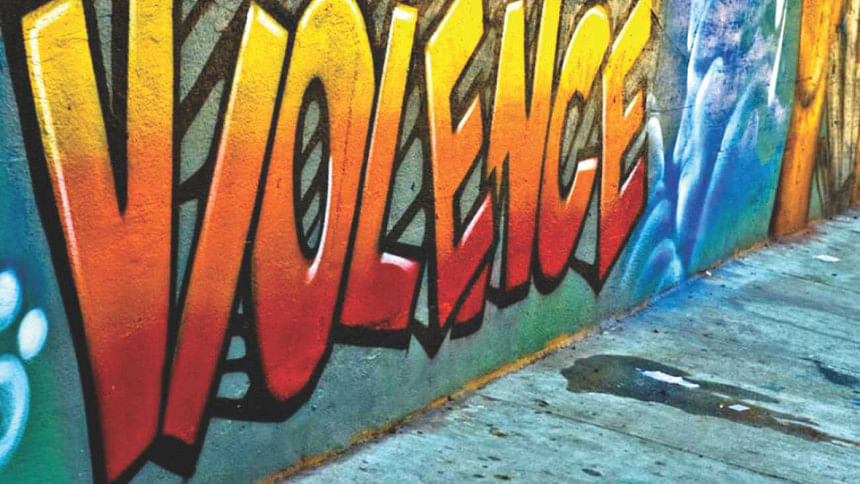The youth's romance with violence

15-year-old Adnan Kabir's death at the hands of teenage gangs has come as a shock to many adults, especially parents who had no inkling of the existence of such gangs. But it isn't a newborn phenomenon, as many of us with fresh school memories can readily attes to. It has been a part of the school culture in Bangladesh for decades, even among the more prestigious institutions.
Most student bodies comprise of social cliques. These groupings take on violent forms in Bangladesh, or at least in Dhaka from what we've witnessed, particularly among males. Friends and acquaintances flock together to form gangs, and the gangs in turn form alliances to exchange protection when feuds break out. Nearly all members boast allegiance (or 'backup', as the parlance goes) with stronger and older honorary 'brothers' who are brought in to deal justice to serious offences. Taken out of the school grounds and into the graffitied alleys that glorify their brands of cruelty, the matter takes on especially strong implications involving fists in the best of circumstances and deadly weapons in the worst. Visualise these murky political dynamics and then remind yourself that they're made up of children aged as young as 13 or 14.
Teenagers' glorification of danger and dominion can be sympathised with given their malleable states of mind. Even a few years ago, most of them could have been expected to grow out of it as the realities of higher education and professional life sunk in. But the recent past has shown a faltering in the ebb of bullying tendencies. They tend to engage in the same destructive activities upon entering and graduating from universities, especially if they are unable or disinclined to find jobs. As the pile up of bullies continue to cast shadows on each new generation, more and more young minds are sucked into this vortex of brutality and destruction. It's alarming that such a vast number of people are unable to grow out of their immature fascination with domination; that they still equate respect with cruelty and feel the same inclination towards darker sentiments as an adult that they did when they were young and impressionable, so intricately has violence woven itself into our social fabric.
Heightened social segregation has played a role. I can recall many classmates who were involved in such feuds back in school. As we graduated from high school and entered university, however, nearly all of them discorded their bullying behaviour; not necessarily through counselling or deliberate efforts, but simply because they grew up. Discussions with my younger cousins reveal the ways in which the culture has evolved since then. Today, teenagers are either very strictly pro-gang culture or against it, with the latter deeming the former as culturally and intellectually inferior. Those with a penchant for violence are shunned and made fun of, who in turn think of their anti-violence classmates as disconnected from reality.
These very rigid lines have caused the aggression contained within a certain social group to fester and gain strength, separated as they are from the exchange of ideas and open-mindedness with their peers. It is no longer just a divide between English and Bangla-medium students, contrary to popular belief, but a case of differing ideologies creating starkly different human beings within the same age and socio-economic backgrounds. An example can be found in last year's viral video of a young man named Xunayed repeatedly beating up a friend who refused to retaliate. Xunayed's pride in his insane cruelty on the one hand, and the educated masses' treatment of him as the most widely circulated social media joke on the other, perfectly demonstrated these ideological divides.
Adults hoping to solve these issues need to gain the right perspective and understand the youth that they're trying to save. Instead of painting something as vast as the Internet and western media with broad negative strokes, they have to realise that the problem lies in the youth's inability to choose correctly from a plethora of influences available to them. Literature and media have contained an abundance of content relating to violence, warfare, and other sensitive topics since the beginning of time; we wouldn't have classics like The Illiad, War and Peace, Ulysses, or The Godfather otherwise. What's frightening is that the young are no longer able to draw the line between intrigue and imitation, and choose to absorb useful lessons from cross-cultural exposure while picking apart the negative aspects it entails.
Barack Obama, in his interview with The New York Times last week, spoke of the role played by books in his experience as a world leader for the past eight years. "There are writers who I don't necessarily agree with in terms of their politics, but whose writings are sort of a baseline for how to think about certain things," he said. "I'm using writing like that as a foil or something to debate against." That's what we lack – the space to explore, think, and respectfully debate against opposing views without resorting to violence. We have justified this for far too long; but when an increasing number of young people take pride in being able to cause harm, generate fear and pain, and overrule others' choices through force, something is very, very wrong.
It is no longer advisable but imperative to bring about reforms in our education – not merely through updated syllabi and ambitious accreditations – but in the very attitude towards learning among the youth. Parents and teachers must close a firm lid on rote methods that require students to wordlessly swallow any and all information they are fed, and mould them to think for themselves. Creativity, through subjects of the Arts and Humanities as well as in the way they learn the more technical subjects, needs to be practised. Intellect and open-mindedness, not power, need to be promoted. Students must be broken free of the thought process that causes them to view critical questions in examinations as an injustice dealt against them, and pushed to think critically and compassionately. Poor or deceptive exam results may seem like the most direct outcome of such herd mentality, but its worst manifestation lies in the ceaseless cases of murder, rape, assault, even child marriage, and the recent upsurge of terrorism amongst us. On January 18, this newspaper reported a 17 year old being beaten to death in Tangail over a cricket match, while two students beat up a classmate in Chittagong University just two days later. We must stop treating these as isolated incidents.
Yes, we need public spaces, alternate forms of leisure and exercise, and a deviation from harmful influences; but simply providing them isn't a solution. We have to inspire the young to choose the healthier options we're hoping to offer, and de-glamorise danger in their eyes.
The writer is an intern at the Editorial section, The Daily Star.

 For all latest news, follow The Daily Star's Google News channel.
For all latest news, follow The Daily Star's Google News channel. 



Comments